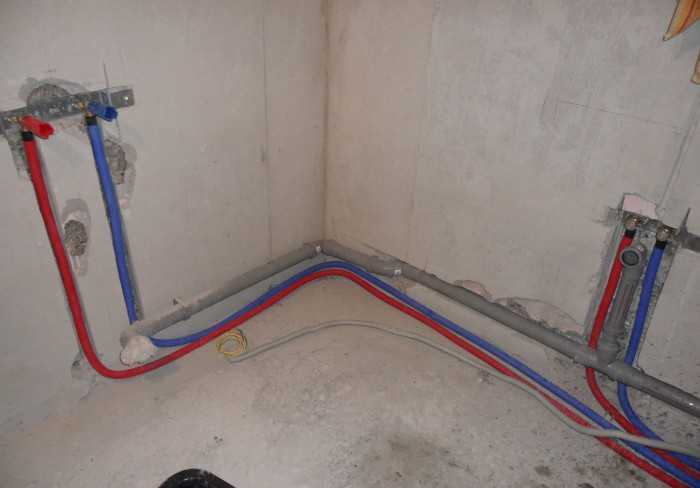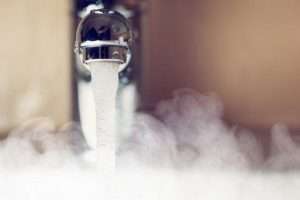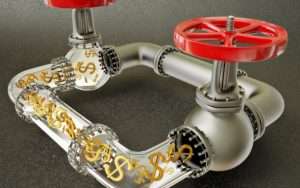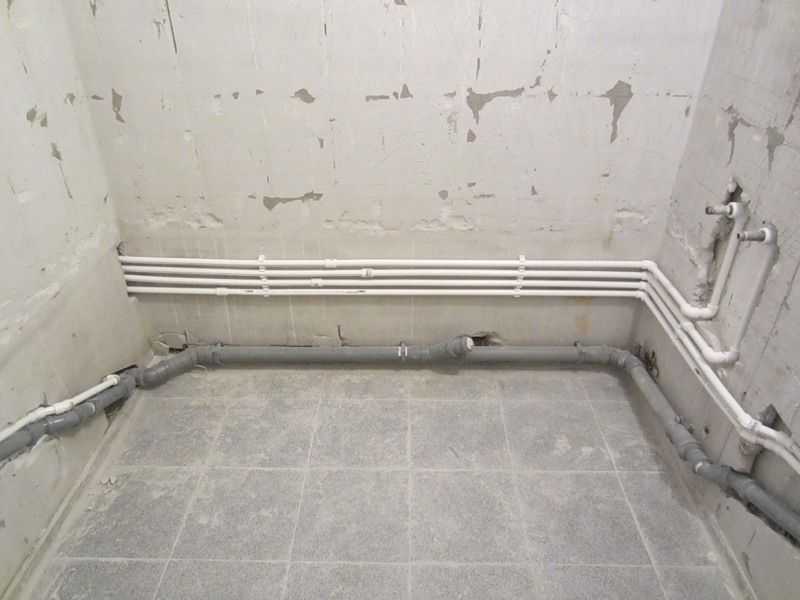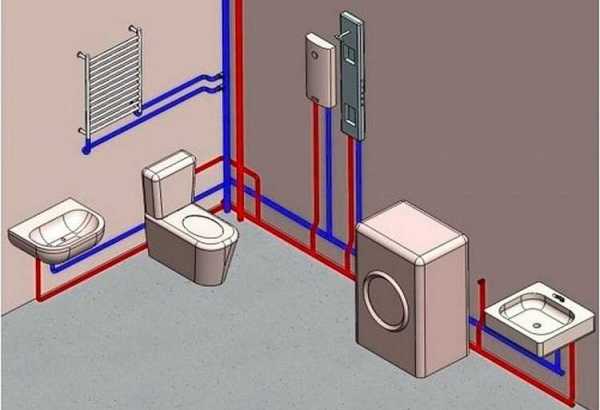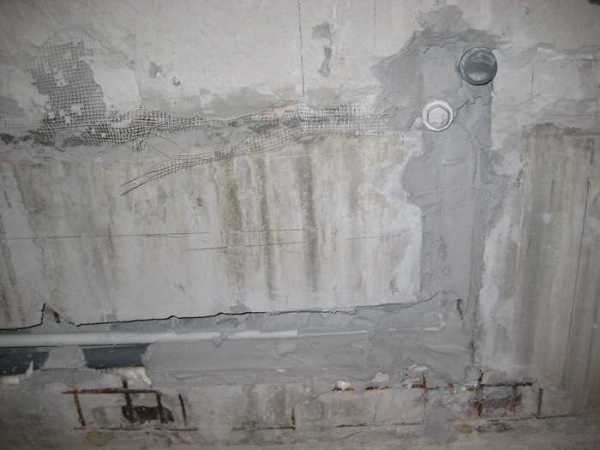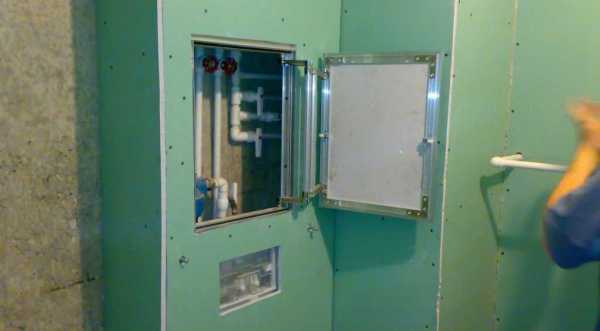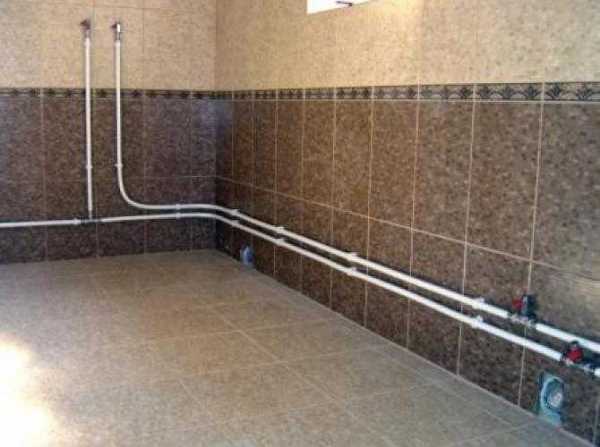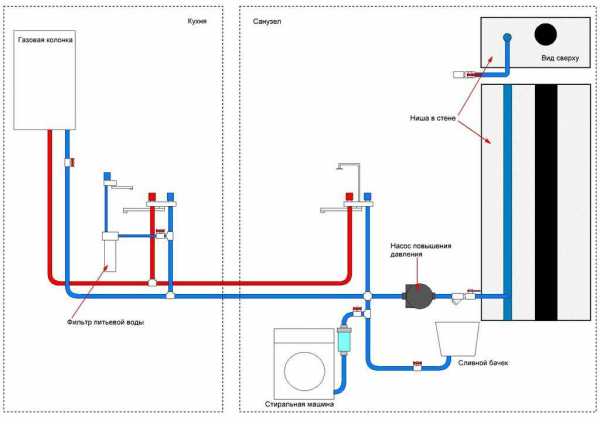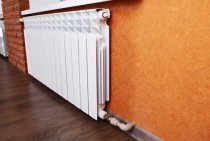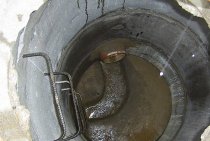Hot faucet must be left or right
Open laying of connections to sanitary appliances is allowed, as well as in places where mechanical damage to plastic pipelines is excluded.
Pipes and fittings must withstand:
- test water pressure exceeding the operating pressure in the network by 1.5 times, but not less than 0.68 MPa, at a constant temperature of cold water - 20 ° C;
- constant water pressure equal to the operating water pressure in the network, but not less than 0.45 MPa, at a constant cold water temperature of -20 ° C for a 50-year estimated period of operation.
Pipeline, water folding and mixing fittings for domestic and drinking water supply systems are set to a working pressure of 0.6 MPa (6 kg / cm²); fittings for individual fire-fighting systems and household fire-fighting water supply - for a working pressure of not more than 1.0 MPa (10 kg / cm²).
To ensure the specified pressure in the building's water supply system, it is necessary to install pressure regulators at the water supply inlet to the building if the pressure in the external network exceeds 45 meters of water column. Pressure regulators at the inlet to the apartment are mounted after the shut-off valves at the inlet.
Vertical pipes of cold water supply systems are located to the left of the hot water risers. Horizontal piping from risers to appliances is laid under hot water pipelines.
Despite the fact that plastic pipelines have lower thermal conductivity and, accordingly, greater self-insulation compared to metal pipes, in some cases they must be insulated. For hot water and heating, pipe insulation prevents heat loss, and for cold water, heating and moistening of pipes. The most effective are heat-insulating pipe shells based on foam plastics - foamed polyethylene, polyurethane, rubber. Thermal insulation made of foamed polymeric materials is supplied in the form of pipes and plates. Tubular shells are used for thermal insulation of pipelines with an outer diameter of 16–160 mm. The thickness of the insulating layer is 6; 9; thirteen; twenty; 25; 32 mm.
Between the metal-polymer pipelines of hot and cold water, the clear distance must be at least 25 mm (taking into account the thickness of the thermal insulation). When crossing metal pipelines, the distance between them must be at least 30 mm.
The minimum diameters of pipes connected to plumbing fixtures are assigned according to the table on page 5. For manifold connections, this diameter is maintained until connected to the manifold. The diameters of the pipelines of the water risers in the sectional assembly should be selected according to the estimated second flow of water in the riser (depending on the number of water folding devices) with a coefficient of 0.7. At the same time, the speed of water movement in pipelines of internal water supply networks, including during fire extinguishing, should not exceed 3 m / s. Usually the speed of water movement is taken to be about 1.5 m/s. Exceeding the speed leads to an increase in the noise of the pipeline.
For more information, please contact SNiP 2.04.01-85 "Internal water supply and sewerage" or plumbing engineers.
Ask your questions. We will reply to you by email as soon as possible. Answers to the most frequently asked questions will be posted on this page.
Thermostatic mixer Varion Samson.
Which side of the faucet should have hot water and which side should have cold water?
Pretty tight travel of the temperature controller in extreme positions. Is this a feature of the regulator or a malfunction? Is it necessary to replace, adjust or develop?
Hello! The stroke of the regulator in the extreme positions is really tighter - this is completely normal and necessary for convenience when fine-tuning the temperature. Over time, with very frequent rotation, the stroke can be developed.
Which plumbing pipes are best
It is impossible to say unequivocally which pipes are best for wiring - there is no ideal material, there are more or less suitable for these conditions. Let's dwell on the most popular options, their advantages and disadvantages:
Polypropylene pipes
The option is good for everyone, except for a large thermal expansion - up to 5 cm per 1 meter, and this is a lot. With a long route, it is necessary to install a compensator or use reinforced pipes. They have much less thermal expansion, but the prices are higher. For hot water, it is definitely necessary to use reinforced pipes, but with fiberglass or foil - it's up to you. The distribution of cold water pipes can be done with a conventional PPR pipe for cold water - here thermal expansion is not so critical.

Polypropylene pipes for plumbing - an excellent choice
Another point that is relevant if you do the work yourself, you are going to do a hidden laying of communications - the quality of the connections. In principle, there is nothing complicated, but without experience you can “screw up”, as a result, after a while the connection may leak. In the absence of experience in welding polypropylene, it is very undesirable to hide the joints under the finish. In this case, it is better to choose an open laying method.
The layout of polypropylene pipes in the bathroom and toilet has many positive aspects:
- a correctly made connection turns out to be monolithic;
- there is no narrowing of the pipeline diameters in the places of soldering;
- high maintainability;
- long service life;
- ease of installation.
In general, it is not for nothing that this material has been so popular lately.
PVC for plumbing
When laying PVC pipes, an adhesive joint is used. There is a special glue that dissolves the top layer of the polymer. Both parts to be glued are lubricated with it, pressed against one another and held for some time. As a result, the connection is almost monolithic, strong and reliable.
There are two types of connection: butt, when two pipe sections are joined and using fittings. Fittings are easier to work with, but the joints are narrower. With a butt joint, there are no narrowings, but it is much more difficult to make it qualitatively.
In principle, all the pros and cons are the same here, a few minuses are added - it is only suitable for transporting cold environments - no more than + 40 ° C, that is, other pipes will have to be used for hot water supply. Scratches and chips reduce the strength of the pipe, therefore, a threaded connection is excluded.
metal-plastic
The layout of the water supply from metal-plastic pipes is also suitable for hot water supply - it can withstand temperatures up to + 105 ° C. A positive difference from all of the above is its high plasticity - these pipes can be bent with a fairly small radius. This simplifies and reduces the cost of installation (fittings are expensive).

Metal-plastic - not the best choice
The disadvantage of using metal-plastic pipes for plumbing is a strong narrowing at the joints - in fittings. This results in a significant pressure drop in the system. This is what limits their use.
Why does cold water push hot water into the faucet?
Thank you all, I found a solution to the problem on some forum, it's all about the divider filter. Over time, limescale clogged small holes inside it, washing the dirt no longer helps, because of this, the normal exit of water from the mixer is disturbed, it is, as it were, partially plugged, and there are more holes in the shower head, the water outlet is normal there, therefore there was a difference in balance when switching to a shower. I just checked it - I removed this mesh and without it everything began to be regulated normally. Here is such a penny thing that took out my brain for three months, it's not a problem to buy a new one.Everyone who answered - your options also have a chance to be correct, sorry, let the system choose the best answer
moderator chose this answer as the best
add to favorites link thank you
In general, in a ceramic faucet box, the balance of water temperature is generally regulated by a fairly short turn of the flywheel. In your case, as a result of some kind of malfunction, this lack of a ceramic faucet simply got worse.
Therefore, try to put instead of ceramic faucets, ordinary worm. I think that it will take a few turns longer to turn them, but it will be much easier to catch the temperature balance.
In addition, you should remove, disassemble, and inspect the mixer itself. I just know from experience that tap water, in terms of its qualities, does not always correspond to GOSTs. And although it is quite suitable for use, it may contain dissolved substances that can settle on pipes and clog them. So, you need to carefully examine not only the faucet boxes, but also the switch for the water pressure on the shower. The problem may be not only in its clogging, but it can also be installed with a slight offset. And therefore, when it is switched, the temperature regime is violated. Here a lot depends on the design of the mixer itself.
add to favorites link thank you
There may be many different reasons. It is possible that something got into the hot water tap in the bathroom, therefore, with the same degree of opening of the taps, the flow of hot water is much less than cold.
When switching from gander to shower and back, the balance is rarely maintained, as this switch is rarely of high quality. Or maybe something got into the switch, too.
Disassemble everything, remove foreign objects, put new gaskets.
add to favorites link thank you
The phenomenon is called submixing, it lies in the fact that somewhere there is a connection between the hot water and cold water risers. And it turns out due to a malfunction of the mixers, due to incorrect connection of the boiler.
Or incorrect connection of dishwashers or washing machines to both pipes. Often neighbors are to blame for this, having connected their equipment incorrectly.
add to favorites link thank you
Water treatment technologist, ecologist
In fact, this is not always the case. In many countries, the connection of hot and cold water is not regulated in any way, incl. and in the countries of the post-Soviet space. Although earlier it was written in SNiP: Pipes of hot water supply systems are located, as a rule, to the right of cold water risers. But even here we are not talking about the mixers themselves, but about the pipes. Yes, and the words usually say that there may be exceptions. In SNiP 3.05.01-85, which replaced the old rules, there is no mention at all of how the blue and red taps should be located. But Soviet builders apparently continued out of habit to put them according to the old standard, so in many houses of the Soviet era you can see hot water on the right, especially if the faucets are old valves. In new faucets, the blue dot is often on the right, but the connections to the faucets are usually flexible, so they can be connected to the pipes in any way.
In countries where this situation is regulated, cold water should be on the right for safety reasons. To prevent burns, you first need to open cold water, gradually adding hot water to the desired temperature. Since most people are right-handed, it is more convenient to open the right faucet first. In addition, it is more economical - cold water, which is cheaper, is spent first.
One can only guess what the authors of the old Soviet SNiP were guided by.
Why is the hot water faucet always on the left
Some believe that there is nothing wrong with this, but this opinion is incorrect. After all, the liquid supplied from the cold pipeline is used for cooking, we wash fruits and vegetables with it, and finally, we drink it.
Therefore, for these purposes, cold water supply is equipped with appropriate cleaning filters and contains certain impurities that make water suitable for these purposes.
The hot liquid supplied through the heating main, on the contrary, contains substances that prevent the formation of scale in the system and the so-called “plugs”, which allow extending the service life of the system before expensive repairs are carried out.
However, these impurities are harmful to the human body and you should not experiment with such "food additives" - the consequences can be expensive and not immediately, but after a certain, rather long period of time.
Hot tap water can burn you, be careful
But do not panic and shout “Help!”, Because everything is solved quite simply, namely, you can take the following steps:
- If you live in a multi-storey building and the first case of negligence during welding work takes place, contact the housing and communal services with a complaint drawn up on behalf of the residents of the house with their signatures. Employees of this organization are obliged to consider and satisfy it. In case of ignoring the complaint in this instance, contact the higher regulatory authorities, and if necessary, go to court.
- On an individual basis, you can perform a very simple operation: swap the plugs on the taps for the designations of hot and cold flows. If the valve is single-lever, turn the plug with the designation of flows 180 °. Of course, it will take some time to get used to the change, but this interval will be insignificant.
- In the event that flexible hoses are interchanged, it is possible, without touching the fitting, to swap the union nuts on the pipelines. Such an operation is quite within the power of the landlord with the usual set of tools and will not require the intervention of a professional locksmith.
There is another nuance that explains why hot water flows from a cold tap.
The fact is that in a number of regions, utilities, in order to save time and labor, are laying water supply and heating lines not underground, but above it, and at a short distance so that they can step over, insulating their “creations” with various materials, for example, glass wool, felt.
Why does hot and cold water flow from the faucet
This leads to the fact that after some time the protective coating is destroyed under the influence of climatic conditions and due to mechanical damage. So, in the hot season, pipelines heat up in the sun so much that when cold water is turned on, a warm stream flows from the system. There is nothing wrong with this, it is enough to leave the tap open for a few minutes, and the liquid will again enter the natural temperature range.
More information in this video.
Circuit examples
The piping in each apartment, even in a typical house, is individual - plumbing and household appliances are arranged differently, of course, the scheme will be different. In reality, everything is not so complicated, you just need to decide on the main parameters of the circuit - where you need to supply water and the type of wiring - will you pull in parallel or in series. Further, everything is dictated by the position of consumers. To make it a little easier, let's add a few more diagrams and photos.

The peculiarity of this scheme is that a thicker pipe from the hot water supply goes to the heated towel rail. This is done to ensure the best heating.

Example of serial wiring - equipment at the entrance to the apartment to increase security


With hidden installation of water pipes, part of the pipes can be hidden in the floor. It will be impossible to repair them, but they are beautiful ...
Each of us several times a day is faced with the need to wash our hands, pour water into a container. And one way or another, we all often use a faucet.But how many of us, without hesitation, will immediately answer the question, from which side is the hot water, and where is the valve that opens the cold one? Surely there are people who are faced with the problem of choosing which faucet to turn, and even more than once burning their fingers under a stream of boiling water, when they hoped to put their hands under cold water. After all, not all faucets clearly indicate in red and blue which side hot and cold water is on. And if you yourself do repairs and carry out plumbing work to connect water to the tap, then how not to confuse the parties and do everything as it should be? Well, let's figure it out together.
Recommendations for the installation of cold water pipelines
For internal cold water pipelines, plastic pipes and fittings made of polyethylene, polypropylene, polyvinyl chloride, polybutylene, metal-polymer, fiberglass and other plastic materials are used - for all water supply networks, except for a separate fire-fighting water supply network. For all internal water supply networks, it is allowed to use copper, bronze and brass pipes, fittings, as well as steel pipes with an internal protective zinc coating against corrosion.
The laying of plastic pipes should be provided mainly hidden: in baseboards, strobes, mines and channels.
Errors in ventilation
No ventilation duct
According to the rules, ventilation ducts must be made in the bathroom, kitchen, deaf rooms (, storage rooms, etc.), separate bathrooms.
Instead of a ventilation channel, an external exhaust hole is made, covered with a grill
An exhaust vent will never replace a ventilation duct, it can only help a little in the matter of ventilation. Especially from it there is little use in non-residential premises. On the other hand, if for some reason it is impossible to install a ventilation duct, and, for example, there is no fireplace or other open fireboxes in the house, then an axial fan can be installed in it, which will provide weak, but still natural ventilation. This method, for example, can get rid of mold in the bathroom.
Installation of windows in which there is no ventilation and ventilators.
Many cheap double-glazed windows often sin with this. Residents notice that after installing a plastic window, they began to feel worse. And the whole point here is that the old wooden windows dried out during their long service life and freely let air in from the street, thus providing this kind of involuntary ventilation. It was so to say "cold but fresh."
Expensive double-glazed windows have ventilators, cheap ones do not have them due to cost reduction.
In addition to feeling unwell, an unpleasant smell can also appear in the house, fungus and mold, condensation on the glass of the window from the side of the room.
They made forced ventilation (for example, an electric hood) where it cannot be done.
And you can’t do it in houses and apartments where,
or any other devices that have combustion products that are discharged outside the house in a natural way (geyser, gas boiler). In this case, there is a violation of traction and the penetration of combustion products into the rooms, and they are poisonous and their presence in the air of the living quarters can lead to very sad consequences.
Note Tips:
It is best if the water is immediately connected to the draw-off point correctly: hot (red pipe) - on the left, cold (blue) - on the right.
In a private house on the outer wall, from the side of the garden, it is convenient to install a cold water tap, to which you can connect a garden hose
The water supply system (as well as the sewerage system), so that the water does not freeze in it, should be laid in the ground below the freezing zone, although this is more laborious than laying at a shallow depth.
A wall mixer, to which water is supplied in the opposite way, is inconvenient to use.By connecting such a mixer with flexible hoses, you can correct the error by connecting the supply hoses crosswise.
In houses with several baths or an extensive DHW system, only a boiler with a boiler can provide real comfort.
Ventilation of the sewer riser does not decorate the roof, but it is necessary for the proper functioning of the sewer system.
Sewer revisions (pipe sections with a hole and a cover) make it possible to clean the sewer pipe if necessary.
The cooker hood must be connected to a separate ventilation duct. When the hood above the stove is not working, the second ventilation duct provides free air exchange.
In new airtight houses, proper functioning of natural ventilation is possible only if air can enter the premises through special window ventilators, or even better, be blown by fans installed in windows or walls.
For free movement of air between rooms, holes must be made in the lower part of the doors.
The gas supply system laid over the foams does not look aesthetically pleasing, but is safe and meets the requirements of regulatory documents
Layout of water supply pipes installation, scheme and approaches
Independent wiring of hot and cold water pipes in an apartment or house is not an easy task, but real. Even if you are going to hire a specialist, you should know the main points yourself - control will not hurt.
Today, in most cases, piping in the bathroom is made of polymer pipes - polypropylene for plumbing, PVC for sewerage
How to develop a plumbing layout
First, determine the places where all consumers of cold and hot water will be located. It is better to do everything on the plan, but you can also mark it “on the spot”. Not only the geometric dimensions of the devices are important, but also the exact location of the place where the water must be brought.
Draw a plan with dimensions and distances - the first step
Many devices are connected to the water supply network using flexible hoses. Then the outlet from the line can end 10-20 cm before the device. The main thing is that the connection point is easily accessible. This is necessary for convenient and fast connection maintenance. This connection method is easier to implement - there is no need to accurately calculate the length of the pipe.
There is also a hard water supply to plumbing fixtures or household appliances - pipes to the very entrance. Such a connection is more difficult to perform, therefore this type of wiring is less common. Basically, gas water heaters (columns), bathroom faucets that are attached to the wall are connected this way.
Outdoor or concealed laying
First of all, it is worth deciding on the type of pipe laying - will they go on top or hidden in a wall or floor. Hidden wiring in the bathroom, toilet is good from an aesthetic point of view - nothing is visible. But the pipes are not available, to fix the leak you will have to break the wall, which is not at all pleasing. Therefore, they try to lay only whole pieces without joints in the wall - there is less chance of leakage.
There is another difficulty with the hidden laying of water supply - the need for channels in the wall (strobe) into which pipes are laid. Firstly, not every wall allows you to make strobes in it. For example, in panel houses, where the wall thickness is only about 10 cm, it is definitely not worth making a channel 5-6 cm deep. The slab will lose a significant part of its bearing capacity. What it threatens to explain, probably, it is not necessary. Secondly, laying a strobe in the wall is not the easiest job, even with a puncher it takes a lot of time. So there are more than enough cons for this option.
Another type of hidden pipe connection is behind a false wall. To do this, stepping back some distance from the main wall, a frame is installed, and drywall is placed on it, on which tiles are then laid. The second option for false walls is made of plastic panels.
From a practical point of view, external piping is better - everything is in sight, available for repair at any time. But the aesthetic side suffers. To hide communications, all of them - plumbing and sewage - are trying to lay closer to the floor, then they build on a plasterboard box with a removable lid or top. So all the pipes have free access, and they themselves are almost invisible.
Laying method
In an apartment or house, plumbing is done in two ways - by connecting all consumers in series or by installing a collector, from which a separate pipe goes to each of the devices. Both options are not without drawbacks.
When pipes are connected in series, it takes little, but if more than two plumbing fixtures are connected in a row, the pressure may be insufficient when they work simultaneously. This type of wiring is also called a tee - all branches from the main main pipe are made using tees (sometimes crosses or corners).
With the collector wiring of the water pipe, a lot of pipes go away, in addition, additional equipment is required - a collector for the water supply. So this piping scheme is an expensive undertaking, but the pressure on all connected devices,
hot water left or right
Hot water right or left
In the Construction and Repair section, to the question Should the hot tap be on the left or on the right? What is the correct rule? set by the author Good neighborliness, the best answer is Previously, all Soviet mixers had hot water on the right. In general, it was convenient and already used to it. Sometimes they came across where hot water was on the left, they were reworked for convenience on the contrary. And for some reason, these mixers did not serve for a long time. When the pipes were changed, I decided to buy new faucets to change at the same time. And I decided to read the instructions for the mixers. One Iddis, and German in the kitchen. Both have a 5 year warranty. So in the instructions it is highlighted in large letters that hot water should be on the left. And that these provisions cannot be changed. And I wanted to ask my husband to change. But it would be possible only in the kitchen (to change the plumbing), and in the bathroom it was no longer possible to change, because everything was installed. At first I did not like it, for many years I got used to the fact that hot water is on the right. But we got used to it very quickly.
Reply from 22 replies
Hey! Here is a selection of topics with answers to your question: Should the hot tap be on the left or on the right? What is the correct rule?
Answer from Sleepy-hot-left
Answer from Neurologist Strangely lived 52 years never saw hot water on the left always and everywhere on the right
Answer from Natalya Khomenko I have never seen a hot tap on the left (neither at home, nor abroad). Everywhere right.
Answer from Constantine All European and American faucets are designed with hot water on the left. this must be especially taken into account when installing faucets with automatic water temperature control.
Answer from KEDR_7Usually hot on the left
Answer from Vitaliy KuznetsovOn the left. Eurostandard.) Good luck
Answer from Andrej Dmitrijev It's silly, somehow, to see hot water on the left, probably the plumber was drunk when he installed the taps, but that's how it is with me.
The answer from Vologdastandart does not exist (I was also interested in this issue before). I usually do as people are used to, that is, as it was before (if there is a replacement). In general, I always ask what is best, but there are isolated cases when the alteration, on the contrary, leads to additional crossing of pipes, then I do it so that there are fewer bends. Hands get used quickly tested by experience to both options.
Answer from Truculentus There are no standards and regulations. Based on common sense, they put the cold one on the right so that the right-hander does not get burned, but we don’t give a damn about left-handers - they are a minority.
Answer from YokarifikatorIf the mixer is without designations, then it is both convenient and correct.
Answer from Josef Schweik I can’t say for sure, but most manufacturers seem to think it’s on the left: many mixers have red and blue inserts on the handles, and the red insert (hot water) is usually on the left.
Answer from Elena Lvovna Kuznetsova We have it on the right. Well, mark the hot in red and the cold in blue.
Answer from Heinrich MontDo you know a man's name that starts with "G" and ends with "X"? So remember this person when you install mixers
Answer from Nikolay ZaitsevI would not bother with this. Do as you please.
Answer from In the past VolkovYes, yes.I also see a hot water faucet everywhere on the right.
Reply from 2 replies
Hey! Here are some other threads with relevant answers:
Why is hot water marked on the left on all faucets, and all plumbers connect it on the right
According to the European standard, hot water is on the left, our installation is carried out with the least "headaches" (that is, as convenient as possible, without overlapping the pipes), so it can be both left and right. At the same time, there is no big problem in the kitchen and on the washbasins, you can throw a flexible hose or copper pipes of the mixer. Here, when connecting thermostatic faucets and shower cabins with such a faucet, real problems arise - the faucet simply does not mix water and gives out either cold or hot water). As a way out, we can recommend reconnecting the water on the comb.
They look through the pipes, the hot pipe is usually on the right, and with cold water on the left
Yes, because mixers are made according to European standards
and plumbers - SHOCK, it's our way
Because the plumbers are leading her from the left...
... but lying on the floor on your back ...
What would you burn yourself, Homer Simpson is your idol?
Apparently this is a pattern, just do not get burned. And your photo is funny, it lifts the mood
hot water according to construction technology is always done on the right side and experienced plumbers know this.
But for sure .. I myself used to set it several times and it didn’t turn out in Russian. And most likely, because at first the pipes are changed and then at the end of the repair they bring the mixer with a joyful smile .. And then you suffer, change the red-blue stickers in places until the owner sees :))
because in Soviet times there was a standard in which hot water was supplied to the mixer on the right
I always put the cold one on the right, you use it more often and it’s easier to open it with your right hand somehow, and chips with color, if they don’t fit, can be swapped
I have hot everywhere on the left, and cold on the right, and when you buy mixers, it’s the other way around. if necessary, rearrange the plugs on the valves in places !!!
I think the problem is in different standards. whoever has ever connected a mixer with a thermostat will understand, there is an obligation to make mountains. the water was on the left or sort out the mixer, and this is a minus guarantee
